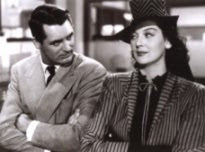Flashforward to 2019 and I'm watching Phil Karlson's "Kansas City Confidential," an installment of Turner Classic Movies' "Noir Alley," hosted by the utterly thorough Eddie Muller. Without missing a beat, Muller invokes the name Bosley Crowther during his post-screening discussion, referencing the critic's near-irrational pan of an otherwise solid film.
After quoting a lengthy portion of Crowther's scathing attack on Karlson and his star John Payne in particular - with the venomous quote also superimposed as an on-screen caption (Chyron) - Muller digs into his bag of words and accurately designates Crowther a "gasbag."
At long last.
Like a certain body part, everybody has one, as the old saying goes (cleaned up here). An opinion, that is. But there are educated opinions, the kind smoothly espoused by Muller - and the kind that seem to evade most professional, working critics, represented by critics like Crowther.
Finally, the impressively knowledegable Muller, who is nothing less than sophsticated, erudite and astute in his taste and brings panache and snap to his presentations, then flings himself into a long overdue critique of Bosley Crowther, equally scathing. Well done. There's a reason why Muller self-describes as "wordslinger, impresario and noirchaelogist."
Muller is an esoteric wordsmith, refreshingly idiosyncratic at times.
As for Crowther, in many other quarters, he was dismissed as "unnecessarily mean" and was particularly questioned about the cluelessness of his take on Arthur Penn's ”Bonnie and Clyde”and his refusal, unlike other reviewers, to re-evaluate it following the controversy of his attack. Instead, he doubled down and retired not long after that.
Yes, Eddie Muller nailed Bosley Crowther with "gasbag."
Note in Passing: Furthermore, any noir whose cast includes Jack Elam, Lee Van Cleef and Neville Brand in supporting character roles, as "Kansas City Confidential" demonstrates, has at least three elements worth recommending. Crowther also ignored the film's contribution of leading lady Coleen Grey. Nothing on Preston Foster either. Unprofessional.
FYI: The 2019 Noir City 71 / 2020 Noir City Program kicks off Sunday, January 25 with screenings of Richard Fleischer's "Trapped" (1949) and Robert Siodmak's "The File on Thelma Jordan" (1950) at the Castro Theater and concludes on February 3, 2020 with Samuel Fuller's "Underworld, U.S.A." (1961) and Allen Baron's "Blast of Silence" (1961)
The September 3rd, 1967 New York Times page containing Bosley Crowther's review of "Bonnie and Clyde"
~click on image to enlarge~
 Regarding Comments:
All comments are enthusiastically appreciated but are moderated before
publication. Replies signed "unknown" or "anonymous" are not
encouraged. Please sign any response with a name (real or fabricated) or
initials. Be advised that a "name" will be assigned to any accepted
post signed "unknown" or "anonymous." Thank you. -J
Regarding Comments:
All comments are enthusiastically appreciated but are moderated before
publication. Replies signed "unknown" or "anonymous" are not
encouraged. Please sign any response with a name (real or fabricated) or
initials. Be advised that a "name" will be assigned to any accepted
post signed "unknown" or "anonymous." Thank you. -J* * * * *
~images~
(from top)
~Eddie Muller, TCM's host of "Noir Alley"
~photography: Turner Classic Movies 2018©
~Poster art for Phil Karlson's "Kansas City Confidential"
~photography: United Artists 1952©
~N.Y. Times tear sheet containing Bosley Crowther's review of "Bonnie and Clyde"
~Eddie Muller, TCM's host of "Noir Alley"
~photography: Turner Classic Movies 2018©
~Poster art for Phil Karlson's "Kansas City Confidential"
~photography: United Artists 1952©
~N.Y. Times tear sheet containing Bosley Crowther's review of "Bonnie and Clyde"
~news page: New York Times 1967©















































